Effective Classroom Dynamics: Strategies for Learning and Development
VerifiedAdded on 2023/06/10
|17
|4895
|428
Report
AI Summary
This report delves into the multifaceted nature of classroom dynamics, exploring how interactions within a classroom environment significantly impact student learning and development. It begins by analyzing the characteristics of group environments that foster learning, emphasizing shared purpose, trust, diversity, and participative leadership. The report then evaluates strategies for managing group dynamics, including building a healthy culture, valuing diversity, and fostering relationships. It also describes ways to involve learners in managing their own learning, such as tapping into prior knowledge and integrating technology. Furthermore, it addresses barriers to individual learning, like emotional and motivational challenges, and provides solutions. The report examines the impact of classroom dynamics on learning outcomes, highlighting the importance of facilitating collaboration and utilizing motivational approaches. It also covers behaviour management solutions, learner rights, and risk minimization. The report concludes by explaining tools for assessing classroom dynamics, such as peer observation and student feedback, and emphasizes the importance of record-keeping. The report provides a comprehensive overview of classroom management techniques, aiming to create positive and effective learning environments.
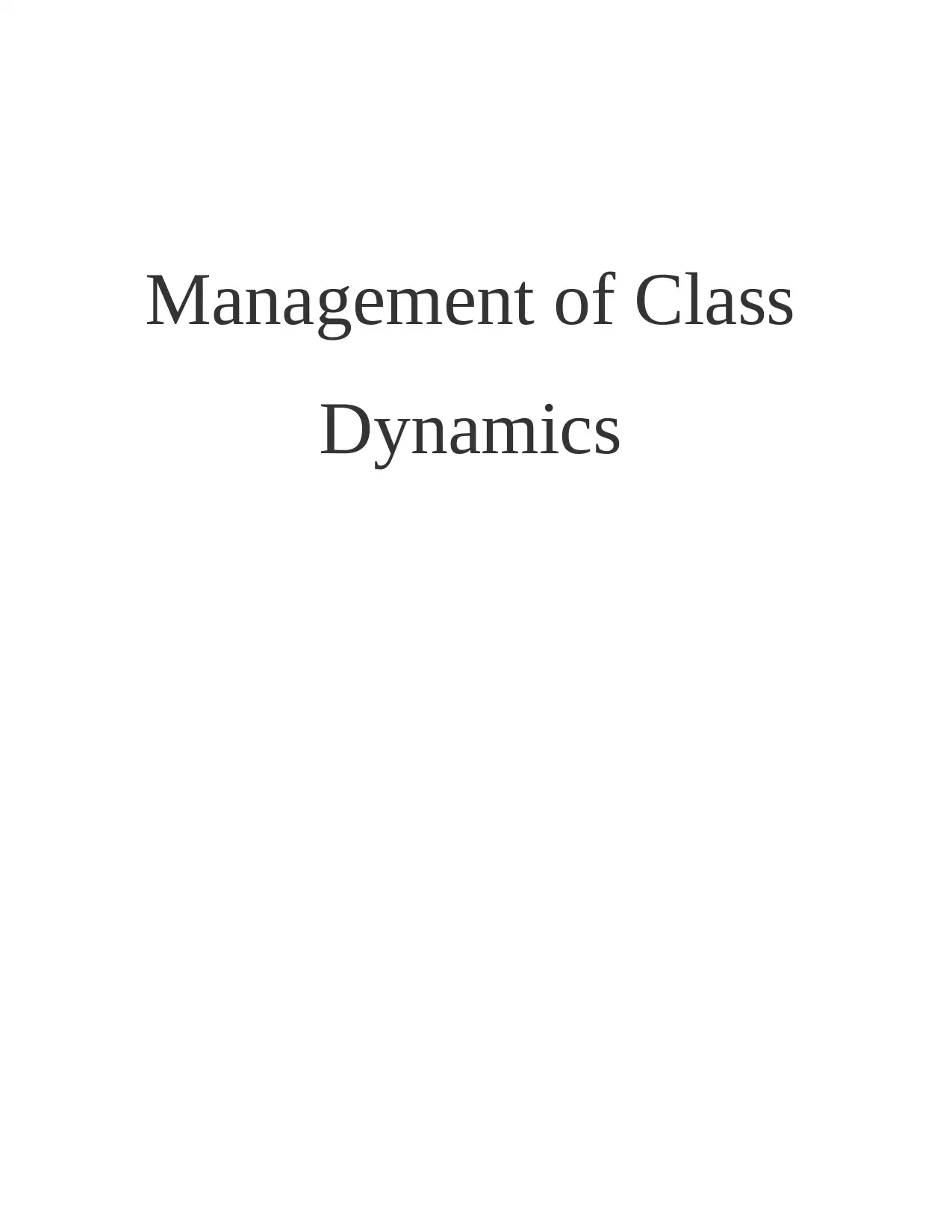
Management of Class
Dynamics
Dynamics
Paraphrase This Document
Need a fresh take? Get an instant paraphrase of this document with our AI Paraphraser
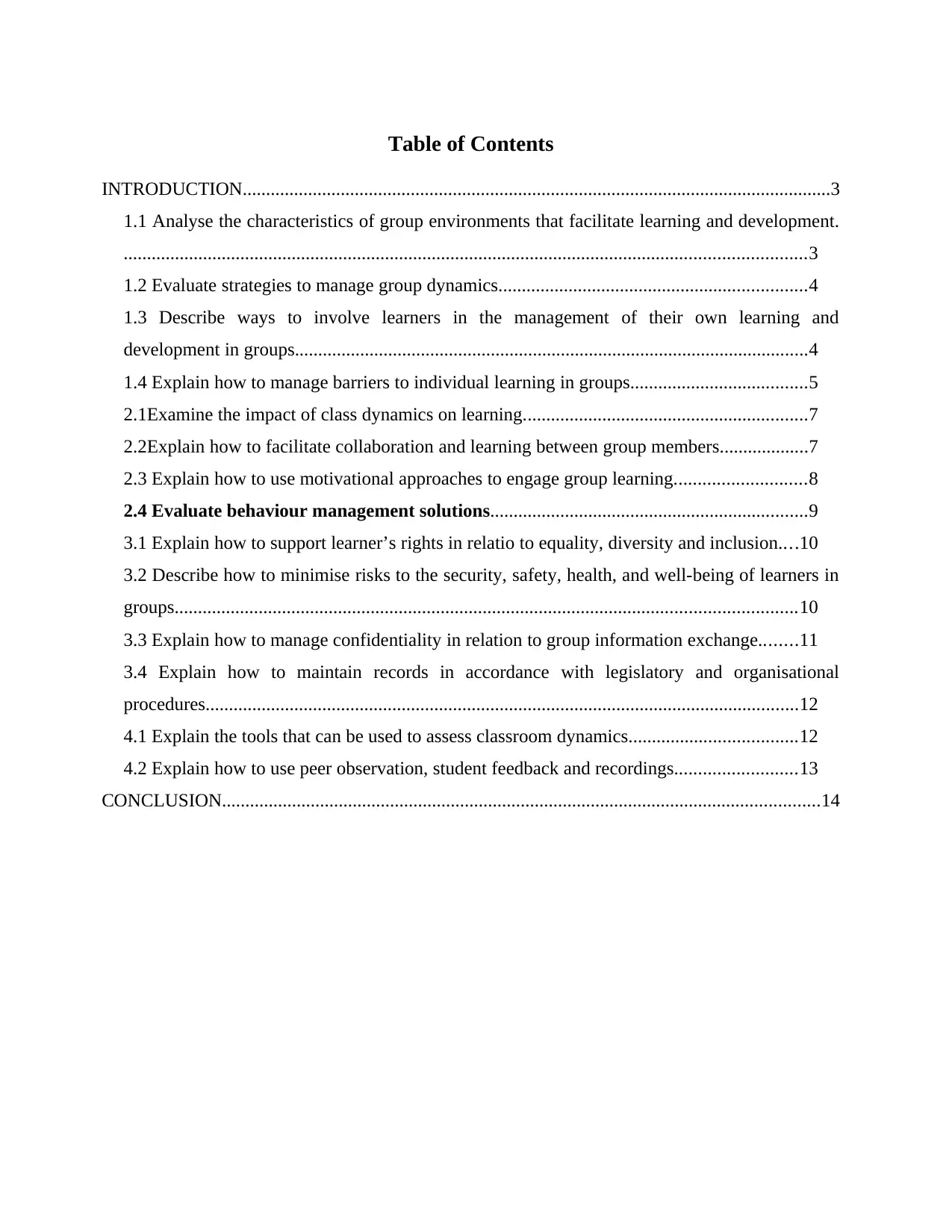
Table of Contents
INTRODUCTION..............................................................................................................................3
1.1 Analyse the characteristics of group environments that facilitate learning and development.
..................................................................................................................................................3
1.2 Evaluate strategies to manage group dynamics..................................................................4
1.3 Describe ways to involve learners in the management of their own learning and
development in groups..............................................................................................................4
1.4 Explain how to manage barriers to individual learning in groups......................................5
2.1Examine the impact of class dynamics on learning.............................................................7
2.2Explain how to facilitate collaboration and learning between group members...................7
2.3 Explain how to use motivational approaches to engage group learning............................8
2.4 Evaluate behaviour management solutions....................................................................9
3.1 Explain how to support learner’s rights in relatio to equality, diversity and inclusion....10
3.2 Describe how to minimise risks to the security, safety, health, and well-being of learners in
groups.....................................................................................................................................10
3.3 Explain how to manage confidentiality in relation to group information exchange........11
3.4 Explain how to maintain records in accordance with legislatory and organisational
procedures...............................................................................................................................12
4.1 Explain the tools that can be used to assess classroom dynamics....................................12
4.2 Explain how to use peer observation, student feedback and recordings..........................13
CONCLUSION................................................................................................................................14
INTRODUCTION..............................................................................................................................3
1.1 Analyse the characteristics of group environments that facilitate learning and development.
..................................................................................................................................................3
1.2 Evaluate strategies to manage group dynamics..................................................................4
1.3 Describe ways to involve learners in the management of their own learning and
development in groups..............................................................................................................4
1.4 Explain how to manage barriers to individual learning in groups......................................5
2.1Examine the impact of class dynamics on learning.............................................................7
2.2Explain how to facilitate collaboration and learning between group members...................7
2.3 Explain how to use motivational approaches to engage group learning............................8
2.4 Evaluate behaviour management solutions....................................................................9
3.1 Explain how to support learner’s rights in relatio to equality, diversity and inclusion....10
3.2 Describe how to minimise risks to the security, safety, health, and well-being of learners in
groups.....................................................................................................................................10
3.3 Explain how to manage confidentiality in relation to group information exchange........11
3.4 Explain how to maintain records in accordance with legislatory and organisational
procedures...............................................................................................................................12
4.1 Explain the tools that can be used to assess classroom dynamics....................................12
4.2 Explain how to use peer observation, student feedback and recordings..........................13
CONCLUSION................................................................................................................................14
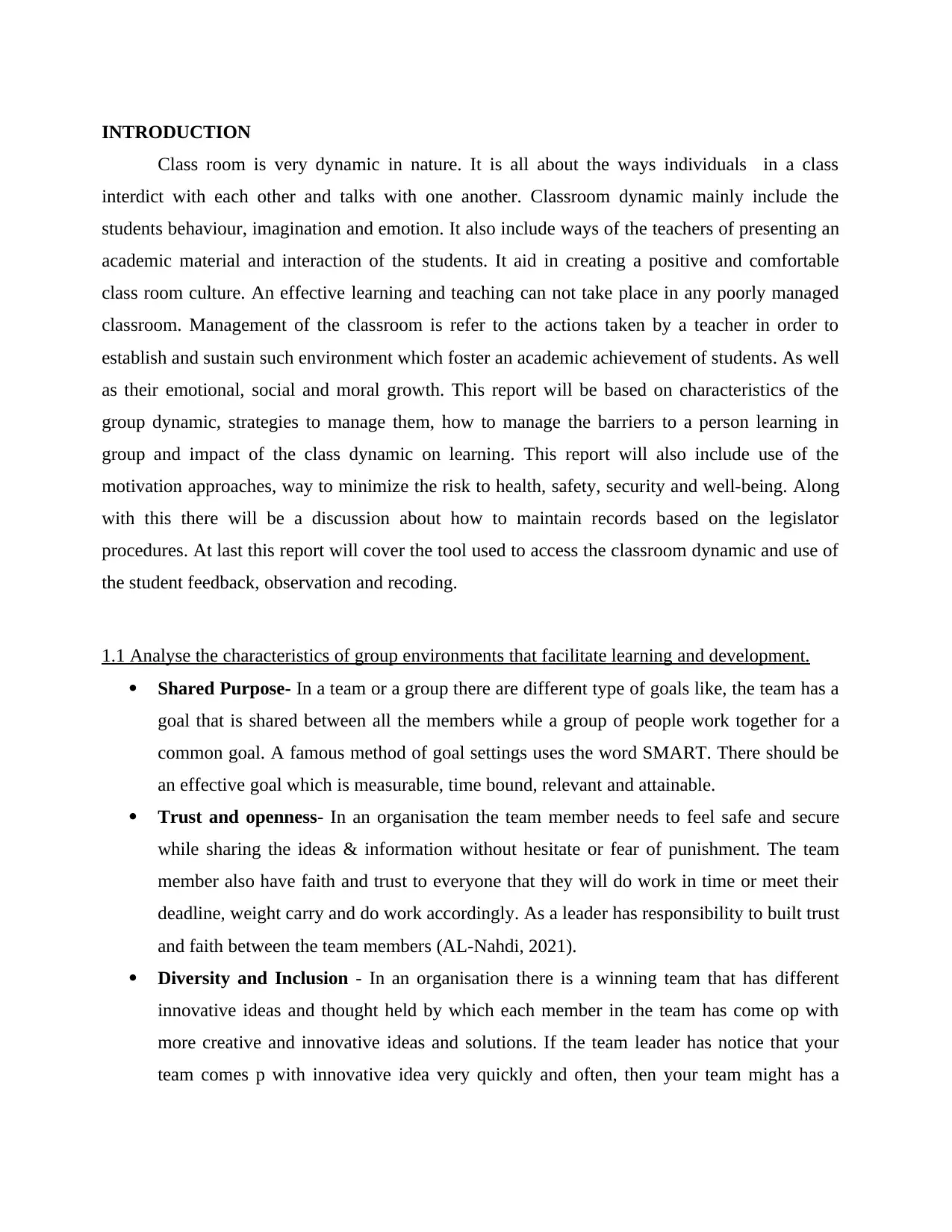
INTRODUCTION
Class room is very dynamic in nature. It is all about the ways individuals in a class
interdict with each other and talks with one another. Classroom dynamic mainly include the
students behaviour, imagination and emotion. It also include ways of the teachers of presenting an
academic material and interaction of the students. It aid in creating a positive and comfortable
class room culture. An effective learning and teaching can not take place in any poorly managed
classroom. Management of the classroom is refer to the actions taken by a teacher in order to
establish and sustain such environment which foster an academic achievement of students. As well
as their emotional, social and moral growth. This report will be based on characteristics of the
group dynamic, strategies to manage them, how to manage the barriers to a person learning in
group and impact of the class dynamic on learning. This report will also include use of the
motivation approaches, way to minimize the risk to health, safety, security and well-being. Along
with this there will be a discussion about how to maintain records based on the legislator
procedures. At last this report will cover the tool used to access the classroom dynamic and use of
the student feedback, observation and recoding.
1.1 Analyse the characteristics of group environments that facilitate learning and development.
Shared Purpose- In a team or a group there are different type of goals like, the team has a
goal that is shared between all the members while a group of people work together for a
common goal. A famous method of goal settings uses the word SMART. There should be
an effective goal which is measurable, time bound, relevant and attainable.
Trust and openness- In an organisation the team member needs to feel safe and secure
while sharing the ideas & information without hesitate or fear of punishment. The team
member also have faith and trust to everyone that they will do work in time or meet their
deadline, weight carry and do work accordingly. As a leader has responsibility to built trust
and faith between the team members (AL-Nahdi, 2021).
Diversity and Inclusion - In an organisation there is a winning team that has different
innovative ideas and thought held by which each member in the team has come op with
more creative and innovative ideas and solutions. If the team leader has notice that your
team comes p with innovative idea very quickly and often, then your team might has a
Class room is very dynamic in nature. It is all about the ways individuals in a class
interdict with each other and talks with one another. Classroom dynamic mainly include the
students behaviour, imagination and emotion. It also include ways of the teachers of presenting an
academic material and interaction of the students. It aid in creating a positive and comfortable
class room culture. An effective learning and teaching can not take place in any poorly managed
classroom. Management of the classroom is refer to the actions taken by a teacher in order to
establish and sustain such environment which foster an academic achievement of students. As well
as their emotional, social and moral growth. This report will be based on characteristics of the
group dynamic, strategies to manage them, how to manage the barriers to a person learning in
group and impact of the class dynamic on learning. This report will also include use of the
motivation approaches, way to minimize the risk to health, safety, security and well-being. Along
with this there will be a discussion about how to maintain records based on the legislator
procedures. At last this report will cover the tool used to access the classroom dynamic and use of
the student feedback, observation and recoding.
1.1 Analyse the characteristics of group environments that facilitate learning and development.
Shared Purpose- In a team or a group there are different type of goals like, the team has a
goal that is shared between all the members while a group of people work together for a
common goal. A famous method of goal settings uses the word SMART. There should be
an effective goal which is measurable, time bound, relevant and attainable.
Trust and openness- In an organisation the team member needs to feel safe and secure
while sharing the ideas & information without hesitate or fear of punishment. The team
member also have faith and trust to everyone that they will do work in time or meet their
deadline, weight carry and do work accordingly. As a leader has responsibility to built trust
and faith between the team members (AL-Nahdi, 2021).
Diversity and Inclusion - In an organisation there is a winning team that has different
innovative ideas and thought held by which each member in the team has come op with
more creative and innovative ideas and solutions. If the team leader has notice that your
team comes p with innovative idea very quickly and often, then your team might has a
⊘ This is a preview!⊘
Do you want full access?
Subscribe today to unlock all pages.

Trusted by 1+ million students worldwide
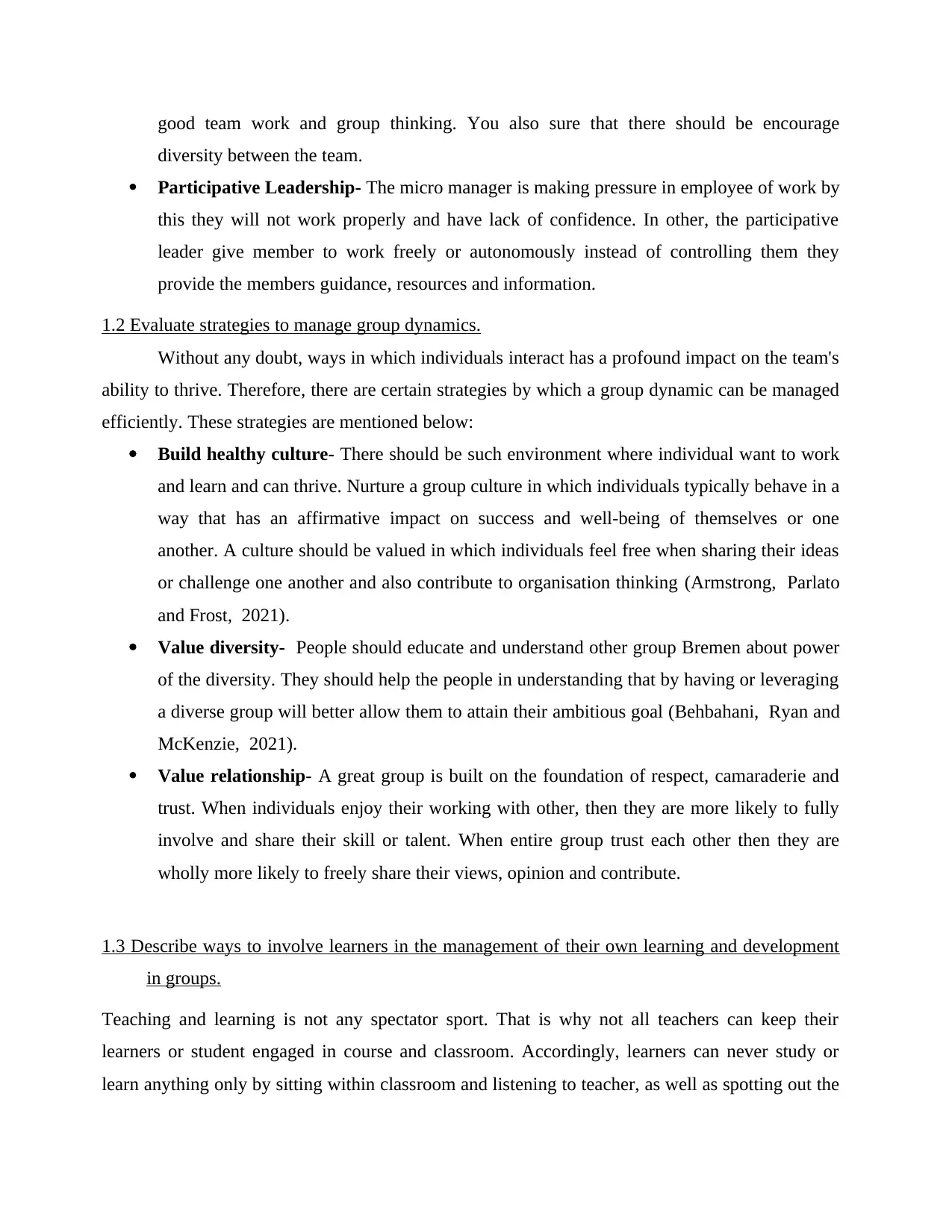
good team work and group thinking. You also sure that there should be encourage
diversity between the team.
Participative Leadership- The micro manager is making pressure in employee of work by
this they will not work properly and have lack of confidence. In other, the participative
leader give member to work freely or autonomously instead of controlling them they
provide the members guidance, resources and information.
1.2 Evaluate strategies to manage group dynamics.
Without any doubt, ways in which individuals interact has a profound impact on the team's
ability to thrive. Therefore, there are certain strategies by which a group dynamic can be managed
efficiently. These strategies are mentioned below:
Build healthy culture- There should be such environment where individual want to work
and learn and can thrive. Nurture a group culture in which individuals typically behave in a
way that has an affirmative impact on success and well-being of themselves or one
another. A culture should be valued in which individuals feel free when sharing their ideas
or challenge one another and also contribute to organisation thinking (Armstrong, Parlato
and Frost, 2021).
Value diversity- People should educate and understand other group Bremen about power
of the diversity. They should help the people in understanding that by having or leveraging
a diverse group will better allow them to attain their ambitious goal (Behbahani, Ryan and
McKenzie, 2021).
Value relationship- A great group is built on the foundation of respect, camaraderie and
trust. When individuals enjoy their working with other, then they are more likely to fully
involve and share their skill or talent. When entire group trust each other then they are
wholly more likely to freely share their views, opinion and contribute.
1.3 Describe ways to involve learners in the management of their own learning and development
in groups.
Teaching and learning is not any spectator sport. That is why not all teachers can keep their
learners or student engaged in course and classroom. Accordingly, learners can never study or
learn anything only by sitting within classroom and listening to teacher, as well as spotting out the
diversity between the team.
Participative Leadership- The micro manager is making pressure in employee of work by
this they will not work properly and have lack of confidence. In other, the participative
leader give member to work freely or autonomously instead of controlling them they
provide the members guidance, resources and information.
1.2 Evaluate strategies to manage group dynamics.
Without any doubt, ways in which individuals interact has a profound impact on the team's
ability to thrive. Therefore, there are certain strategies by which a group dynamic can be managed
efficiently. These strategies are mentioned below:
Build healthy culture- There should be such environment where individual want to work
and learn and can thrive. Nurture a group culture in which individuals typically behave in a
way that has an affirmative impact on success and well-being of themselves or one
another. A culture should be valued in which individuals feel free when sharing their ideas
or challenge one another and also contribute to organisation thinking (Armstrong, Parlato
and Frost, 2021).
Value diversity- People should educate and understand other group Bremen about power
of the diversity. They should help the people in understanding that by having or leveraging
a diverse group will better allow them to attain their ambitious goal (Behbahani, Ryan and
McKenzie, 2021).
Value relationship- A great group is built on the foundation of respect, camaraderie and
trust. When individuals enjoy their working with other, then they are more likely to fully
involve and share their skill or talent. When entire group trust each other then they are
wholly more likely to freely share their views, opinion and contribute.
1.3 Describe ways to involve learners in the management of their own learning and development
in groups.
Teaching and learning is not any spectator sport. That is why not all teachers can keep their
learners or student engaged in course and classroom. Accordingly, learners can never study or
learn anything only by sitting within classroom and listening to teacher, as well as spotting out the
Paraphrase This Document
Need a fresh take? Get an instant paraphrase of this document with our AI Paraphraser
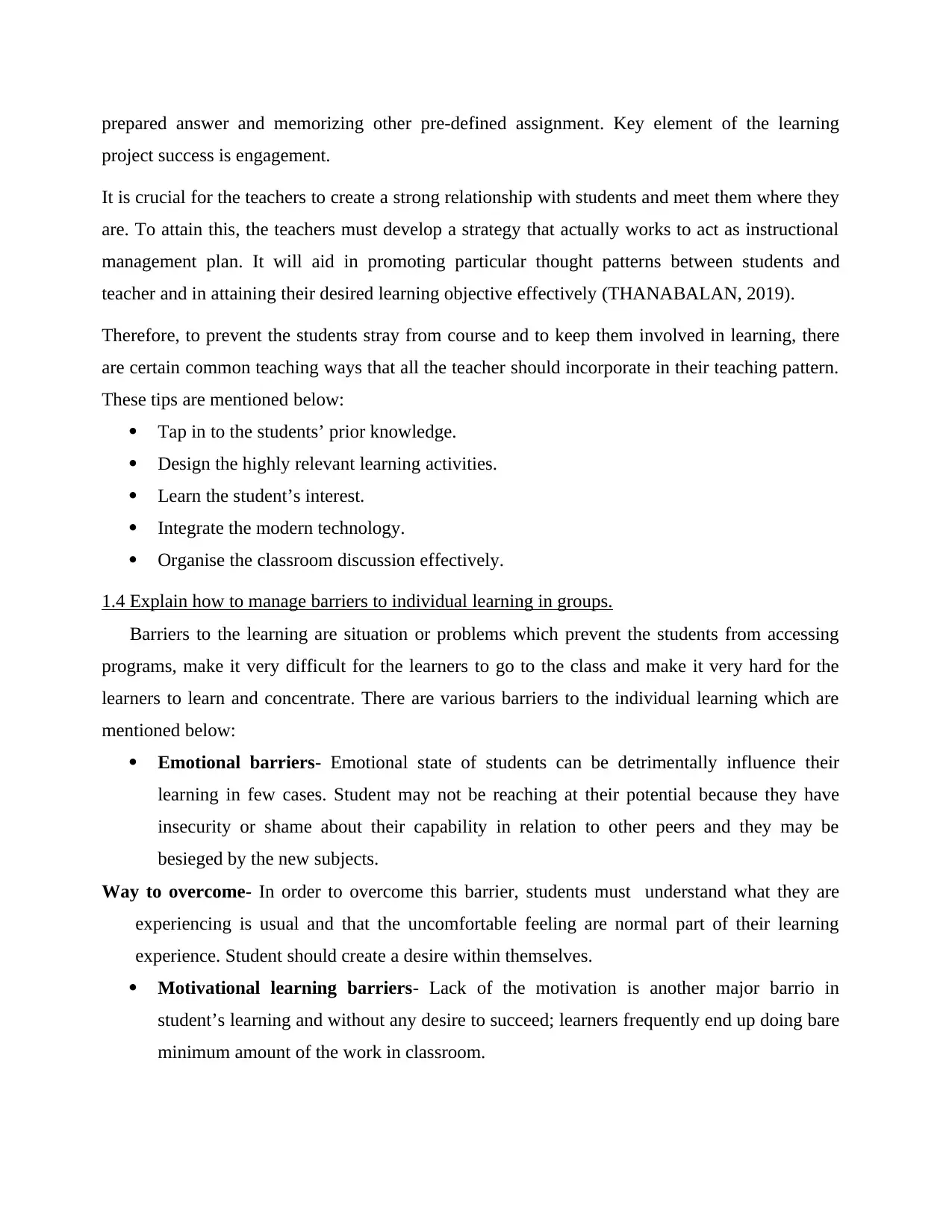
prepared answer and memorizing other pre-defined assignment. Key element of the learning
project success is engagement.
It is crucial for the teachers to create a strong relationship with students and meet them where they
are. To attain this, the teachers must develop a strategy that actually works to act as instructional
management plan. It will aid in promoting particular thought patterns between students and
teacher and in attaining their desired learning objective effectively (THANABALAN, 2019).
Therefore, to prevent the students stray from course and to keep them involved in learning, there
are certain common teaching ways that all the teacher should incorporate in their teaching pattern.
These tips are mentioned below:
Tap in to the students’ prior knowledge.
Design the highly relevant learning activities.
Learn the student’s interest.
Integrate the modern technology.
Organise the classroom discussion effectively.
1.4 Explain how to manage barriers to individual learning in groups.
Barriers to the learning are situation or problems which prevent the students from accessing
programs, make it very difficult for the learners to go to the class and make it very hard for the
learners to learn and concentrate. There are various barriers to the individual learning which are
mentioned below:
Emotional barriers- Emotional state of students can be detrimentally influence their
learning in few cases. Student may not be reaching at their potential because they have
insecurity or shame about their capability in relation to other peers and they may be
besieged by the new subjects.
Way to overcome- In order to overcome this barrier, students must understand what they are
experiencing is usual and that the uncomfortable feeling are normal part of their learning
experience. Student should create a desire within themselves.
Motivational learning barriers- Lack of the motivation is another major barrio in
student’s learning and without any desire to succeed; learners frequently end up doing bare
minimum amount of the work in classroom.
project success is engagement.
It is crucial for the teachers to create a strong relationship with students and meet them where they
are. To attain this, the teachers must develop a strategy that actually works to act as instructional
management plan. It will aid in promoting particular thought patterns between students and
teacher and in attaining their desired learning objective effectively (THANABALAN, 2019).
Therefore, to prevent the students stray from course and to keep them involved in learning, there
are certain common teaching ways that all the teacher should incorporate in their teaching pattern.
These tips are mentioned below:
Tap in to the students’ prior knowledge.
Design the highly relevant learning activities.
Learn the student’s interest.
Integrate the modern technology.
Organise the classroom discussion effectively.
1.4 Explain how to manage barriers to individual learning in groups.
Barriers to the learning are situation or problems which prevent the students from accessing
programs, make it very difficult for the learners to go to the class and make it very hard for the
learners to learn and concentrate. There are various barriers to the individual learning which are
mentioned below:
Emotional barriers- Emotional state of students can be detrimentally influence their
learning in few cases. Student may not be reaching at their potential because they have
insecurity or shame about their capability in relation to other peers and they may be
besieged by the new subjects.
Way to overcome- In order to overcome this barrier, students must understand what they are
experiencing is usual and that the uncomfortable feeling are normal part of their learning
experience. Student should create a desire within themselves.
Motivational learning barriers- Lack of the motivation is another major barrio in
student’s learning and without any desire to succeed; learners frequently end up doing bare
minimum amount of the work in classroom.

Way to overcome- To win over this barrier it so essential for the students to see an obvious
objective, that enhance their interest in task. If they like their learning environment hen it
encourages them to study and bring their interest back.
objective, that enhance their interest in task. If they like their learning environment hen it
encourages them to study and bring their interest back.
⊘ This is a preview!⊘
Do you want full access?
Subscribe today to unlock all pages.

Trusted by 1+ million students worldwide
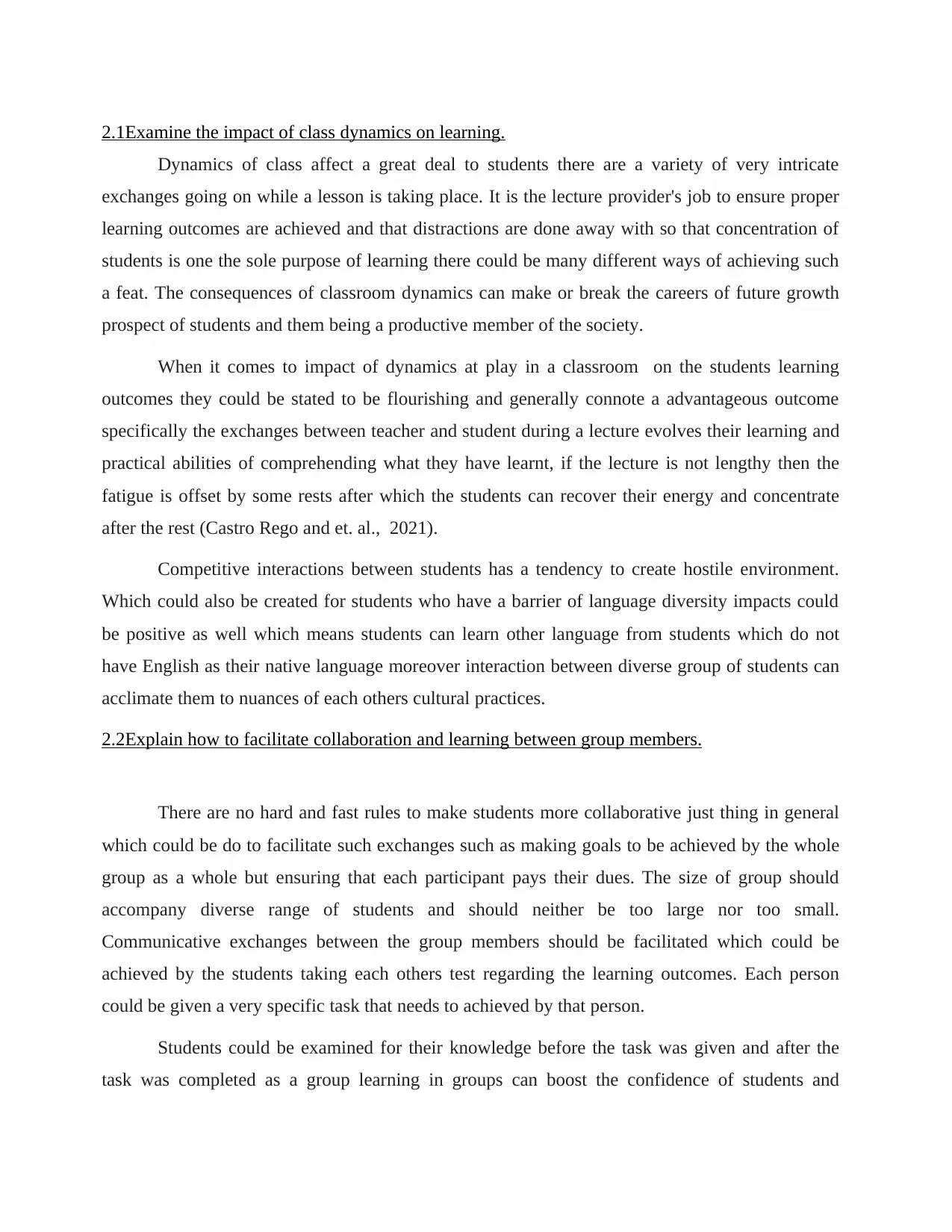
2.1Examine the impact of class dynamics on learning.
Dynamics of class affect a great deal to students there are a variety of very intricate
exchanges going on while a lesson is taking place. It is the lecture provider's job to ensure proper
learning outcomes are achieved and that distractions are done away with so that concentration of
students is one the sole purpose of learning there could be many different ways of achieving such
a feat. The consequences of classroom dynamics can make or break the careers of future growth
prospect of students and them being a productive member of the society.
When it comes to impact of dynamics at play in a classroom on the students learning
outcomes they could be stated to be flourishing and generally connote a advantageous outcome
specifically the exchanges between teacher and student during a lecture evolves their learning and
practical abilities of comprehending what they have learnt, if the lecture is not lengthy then the
fatigue is offset by some rests after which the students can recover their energy and concentrate
after the rest (Castro Rego and et. al., 2021).
Competitive interactions between students has a tendency to create hostile environment.
Which could also be created for students who have a barrier of language diversity impacts could
be positive as well which means students can learn other language from students which do not
have English as their native language moreover interaction between diverse group of students can
acclimate them to nuances of each others cultural practices.
2.2Explain how to facilitate collaboration and learning between group members.
There are no hard and fast rules to make students more collaborative just thing in general
which could be do to facilitate such exchanges such as making goals to be achieved by the whole
group as a whole but ensuring that each participant pays their dues. The size of group should
accompany diverse range of students and should neither be too large nor too small.
Communicative exchanges between the group members should be facilitated which could be
achieved by the students taking each others test regarding the learning outcomes. Each person
could be given a very specific task that needs to achieved by that person.
Students could be examined for their knowledge before the task was given and after the
task was completed as a group learning in groups can boost the confidence of students and
Dynamics of class affect a great deal to students there are a variety of very intricate
exchanges going on while a lesson is taking place. It is the lecture provider's job to ensure proper
learning outcomes are achieved and that distractions are done away with so that concentration of
students is one the sole purpose of learning there could be many different ways of achieving such
a feat. The consequences of classroom dynamics can make or break the careers of future growth
prospect of students and them being a productive member of the society.
When it comes to impact of dynamics at play in a classroom on the students learning
outcomes they could be stated to be flourishing and generally connote a advantageous outcome
specifically the exchanges between teacher and student during a lecture evolves their learning and
practical abilities of comprehending what they have learnt, if the lecture is not lengthy then the
fatigue is offset by some rests after which the students can recover their energy and concentrate
after the rest (Castro Rego and et. al., 2021).
Competitive interactions between students has a tendency to create hostile environment.
Which could also be created for students who have a barrier of language diversity impacts could
be positive as well which means students can learn other language from students which do not
have English as their native language moreover interaction between diverse group of students can
acclimate them to nuances of each others cultural practices.
2.2Explain how to facilitate collaboration and learning between group members.
There are no hard and fast rules to make students more collaborative just thing in general
which could be do to facilitate such exchanges such as making goals to be achieved by the whole
group as a whole but ensuring that each participant pays their dues. The size of group should
accompany diverse range of students and should neither be too large nor too small.
Communicative exchanges between the group members should be facilitated which could be
achieved by the students taking each others test regarding the learning outcomes. Each person
could be given a very specific task that needs to achieved by that person.
Students could be examined for their knowledge before the task was given and after the
task was completed as a group learning in groups can boost the confidence of students and
Paraphrase This Document
Need a fresh take? Get an instant paraphrase of this document with our AI Paraphraser
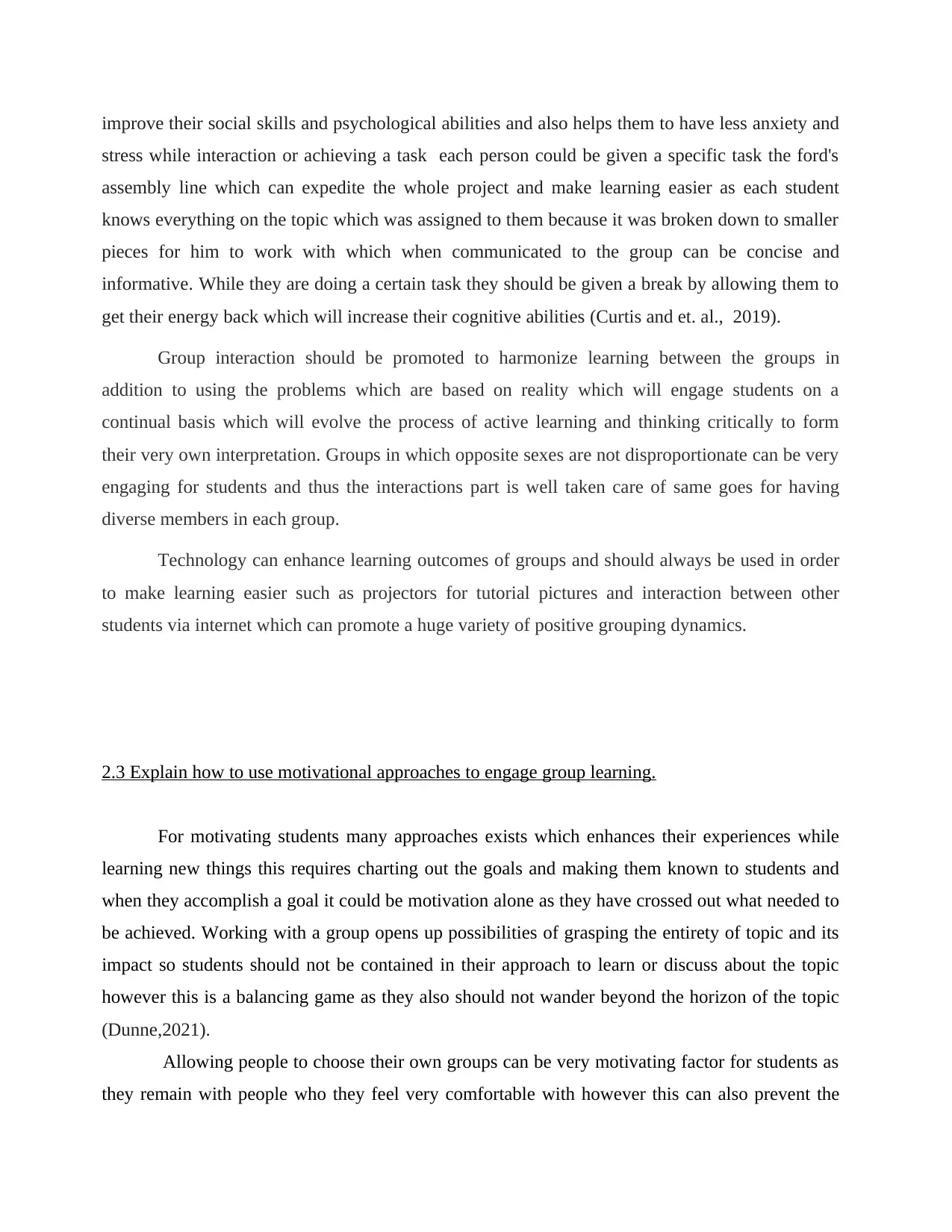
improve their social skills and psychological abilities and also helps them to have less anxiety and
stress while interaction or achieving a task each person could be given a specific task the ford's
assembly line which can expedite the whole project and make learning easier as each student
knows everything on the topic which was assigned to them because it was broken down to smaller
pieces for him to work with which when communicated to the group can be concise and
informative. While they are doing a certain task they should be given a break by allowing them to
get their energy back which will increase their cognitive abilities (Curtis and et. al., 2019).
Group interaction should be promoted to harmonize learning between the groups in
addition to using the problems which are based on reality which will engage students on a
continual basis which will evolve the process of active learning and thinking critically to form
their very own interpretation. Groups in which opposite sexes are not disproportionate can be very
engaging for students and thus the interactions part is well taken care of same goes for having
diverse members in each group.
Technology can enhance learning outcomes of groups and should always be used in order
to make learning easier such as projectors for tutorial pictures and interaction between other
students via internet which can promote a huge variety of positive grouping dynamics.
2.3 Explain how to use motivational approaches to engage group learning.
For motivating students many approaches exists which enhances their experiences while
learning new things this requires charting out the goals and making them known to students and
when they accomplish a goal it could be motivation alone as they have crossed out what needed to
be achieved. Working with a group opens up possibilities of grasping the entirety of topic and its
impact so students should not be contained in their approach to learn or discuss about the topic
however this is a balancing game as they also should not wander beyond the horizon of the topic
(Dunne,2021).
Allowing people to choose their own groups can be very motivating factor for students as
they remain with people who they feel very comfortable with however this can also prevent the
stress while interaction or achieving a task each person could be given a specific task the ford's
assembly line which can expedite the whole project and make learning easier as each student
knows everything on the topic which was assigned to them because it was broken down to smaller
pieces for him to work with which when communicated to the group can be concise and
informative. While they are doing a certain task they should be given a break by allowing them to
get their energy back which will increase their cognitive abilities (Curtis and et. al., 2019).
Group interaction should be promoted to harmonize learning between the groups in
addition to using the problems which are based on reality which will engage students on a
continual basis which will evolve the process of active learning and thinking critically to form
their very own interpretation. Groups in which opposite sexes are not disproportionate can be very
engaging for students and thus the interactions part is well taken care of same goes for having
diverse members in each group.
Technology can enhance learning outcomes of groups and should always be used in order
to make learning easier such as projectors for tutorial pictures and interaction between other
students via internet which can promote a huge variety of positive grouping dynamics.
2.3 Explain how to use motivational approaches to engage group learning.
For motivating students many approaches exists which enhances their experiences while
learning new things this requires charting out the goals and making them known to students and
when they accomplish a goal it could be motivation alone as they have crossed out what needed to
be achieved. Working with a group opens up possibilities of grasping the entirety of topic and its
impact so students should not be contained in their approach to learn or discuss about the topic
however this is a balancing game as they also should not wander beyond the horizon of the topic
(Dunne,2021).
Allowing people to choose their own groups can be very motivating factor for students as
they remain with people who they feel very comfortable with however this can also prevent the
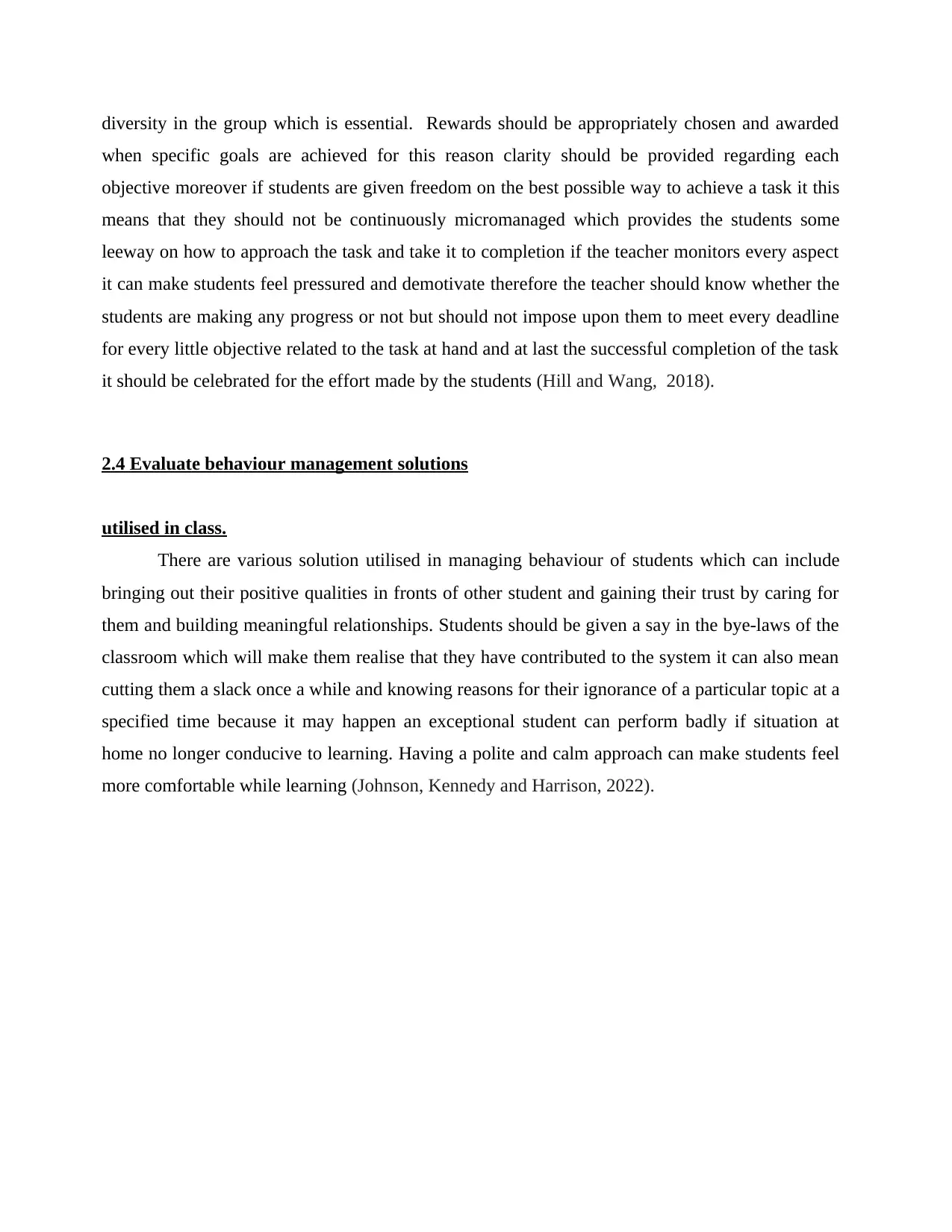
diversity in the group which is essential. Rewards should be appropriately chosen and awarded
when specific goals are achieved for this reason clarity should be provided regarding each
objective moreover if students are given freedom on the best possible way to achieve a task it this
means that they should not be continuously micromanaged which provides the students some
leeway on how to approach the task and take it to completion if the teacher monitors every aspect
it can make students feel pressured and demotivate therefore the teacher should know whether the
students are making any progress or not but should not impose upon them to meet every deadline
for every little objective related to the task at hand and at last the successful completion of the task
it should be celebrated for the effort made by the students (Hill and Wang, 2018).
2.4 Evaluate behaviour management solutions
utilised in class.
There are various solution utilised in managing behaviour of students which can include
bringing out their positive qualities in fronts of other student and gaining their trust by caring for
them and building meaningful relationships. Students should be given a say in the bye-laws of the
classroom which will make them realise that they have contributed to the system it can also mean
cutting them a slack once a while and knowing reasons for their ignorance of a particular topic at a
specified time because it may happen an exceptional student can perform badly if situation at
home no longer conducive to learning. Having a polite and calm approach can make students feel
more comfortable while learning (Johnson, Kennedy and Harrison, 2022).
when specific goals are achieved for this reason clarity should be provided regarding each
objective moreover if students are given freedom on the best possible way to achieve a task it this
means that they should not be continuously micromanaged which provides the students some
leeway on how to approach the task and take it to completion if the teacher monitors every aspect
it can make students feel pressured and demotivate therefore the teacher should know whether the
students are making any progress or not but should not impose upon them to meet every deadline
for every little objective related to the task at hand and at last the successful completion of the task
it should be celebrated for the effort made by the students (Hill and Wang, 2018).
2.4 Evaluate behaviour management solutions
utilised in class.
There are various solution utilised in managing behaviour of students which can include
bringing out their positive qualities in fronts of other student and gaining their trust by caring for
them and building meaningful relationships. Students should be given a say in the bye-laws of the
classroom which will make them realise that they have contributed to the system it can also mean
cutting them a slack once a while and knowing reasons for their ignorance of a particular topic at a
specified time because it may happen an exceptional student can perform badly if situation at
home no longer conducive to learning. Having a polite and calm approach can make students feel
more comfortable while learning (Johnson, Kennedy and Harrison, 2022).
⊘ This is a preview!⊘
Do you want full access?
Subscribe today to unlock all pages.

Trusted by 1+ million students worldwide
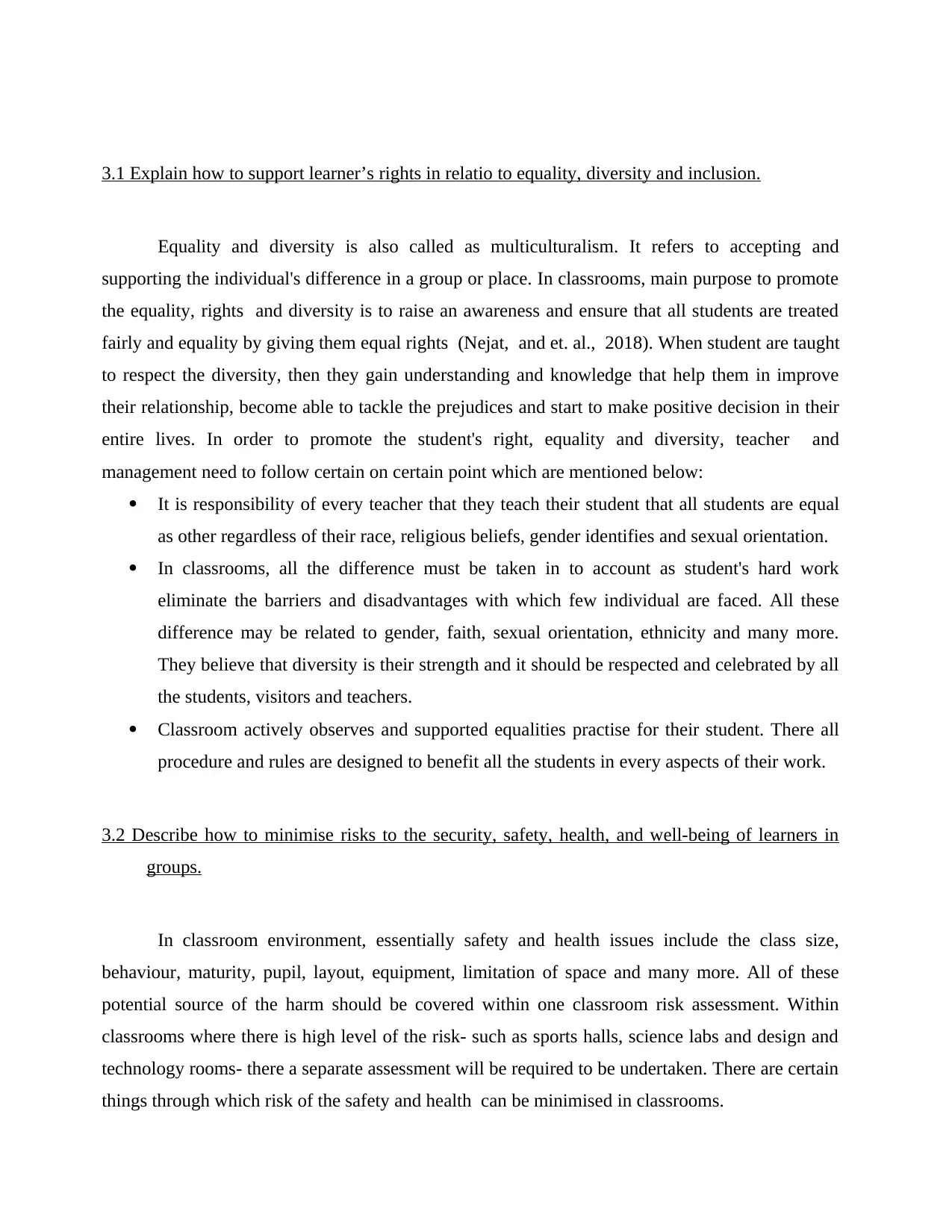
3.1 Explain how to support learner’s rights in relatio to equality, diversity and inclusion.
Equality and diversity is also called as multiculturalism. It refers to accepting and
supporting the individual's difference in a group or place. In classrooms, main purpose to promote
the equality, rights and diversity is to raise an awareness and ensure that all students are treated
fairly and equality by giving them equal rights (Nejat, and et. al., 2018). When student are taught
to respect the diversity, then they gain understanding and knowledge that help them in improve
their relationship, become able to tackle the prejudices and start to make positive decision in their
entire lives. In order to promote the student's right, equality and diversity, teacher and
management need to follow certain on certain point which are mentioned below:
It is responsibility of every teacher that they teach their student that all students are equal
as other regardless of their race, religious beliefs, gender identifies and sexual orientation.
In classrooms, all the difference must be taken in to account as student's hard work
eliminate the barriers and disadvantages with which few individual are faced. All these
difference may be related to gender, faith, sexual orientation, ethnicity and many more.
They believe that diversity is their strength and it should be respected and celebrated by all
the students, visitors and teachers.
Classroom actively observes and supported equalities practise for their student. There all
procedure and rules are designed to benefit all the students in every aspects of their work.
3.2 Describe how to minimise risks to the security, safety, health, and well-being of learners in
groups.
In classroom environment, essentially safety and health issues include the class size,
behaviour, maturity, pupil, layout, equipment, limitation of space and many more. All of these
potential source of the harm should be covered within one classroom risk assessment. Within
classrooms where there is high level of the risk- such as sports halls, science labs and design and
technology rooms- there a separate assessment will be required to be undertaken. There are certain
things through which risk of the safety and health can be minimised in classrooms.
Equality and diversity is also called as multiculturalism. It refers to accepting and
supporting the individual's difference in a group or place. In classrooms, main purpose to promote
the equality, rights and diversity is to raise an awareness and ensure that all students are treated
fairly and equality by giving them equal rights (Nejat, and et. al., 2018). When student are taught
to respect the diversity, then they gain understanding and knowledge that help them in improve
their relationship, become able to tackle the prejudices and start to make positive decision in their
entire lives. In order to promote the student's right, equality and diversity, teacher and
management need to follow certain on certain point which are mentioned below:
It is responsibility of every teacher that they teach their student that all students are equal
as other regardless of their race, religious beliefs, gender identifies and sexual orientation.
In classrooms, all the difference must be taken in to account as student's hard work
eliminate the barriers and disadvantages with which few individual are faced. All these
difference may be related to gender, faith, sexual orientation, ethnicity and many more.
They believe that diversity is their strength and it should be respected and celebrated by all
the students, visitors and teachers.
Classroom actively observes and supported equalities practise for their student. There all
procedure and rules are designed to benefit all the students in every aspects of their work.
3.2 Describe how to minimise risks to the security, safety, health, and well-being of learners in
groups.
In classroom environment, essentially safety and health issues include the class size,
behaviour, maturity, pupil, layout, equipment, limitation of space and many more. All of these
potential source of the harm should be covered within one classroom risk assessment. Within
classrooms where there is high level of the risk- such as sports halls, science labs and design and
technology rooms- there a separate assessment will be required to be undertaken. There are certain
things through which risk of the safety and health can be minimised in classrooms.
Paraphrase This Document
Need a fresh take? Get an instant paraphrase of this document with our AI Paraphraser
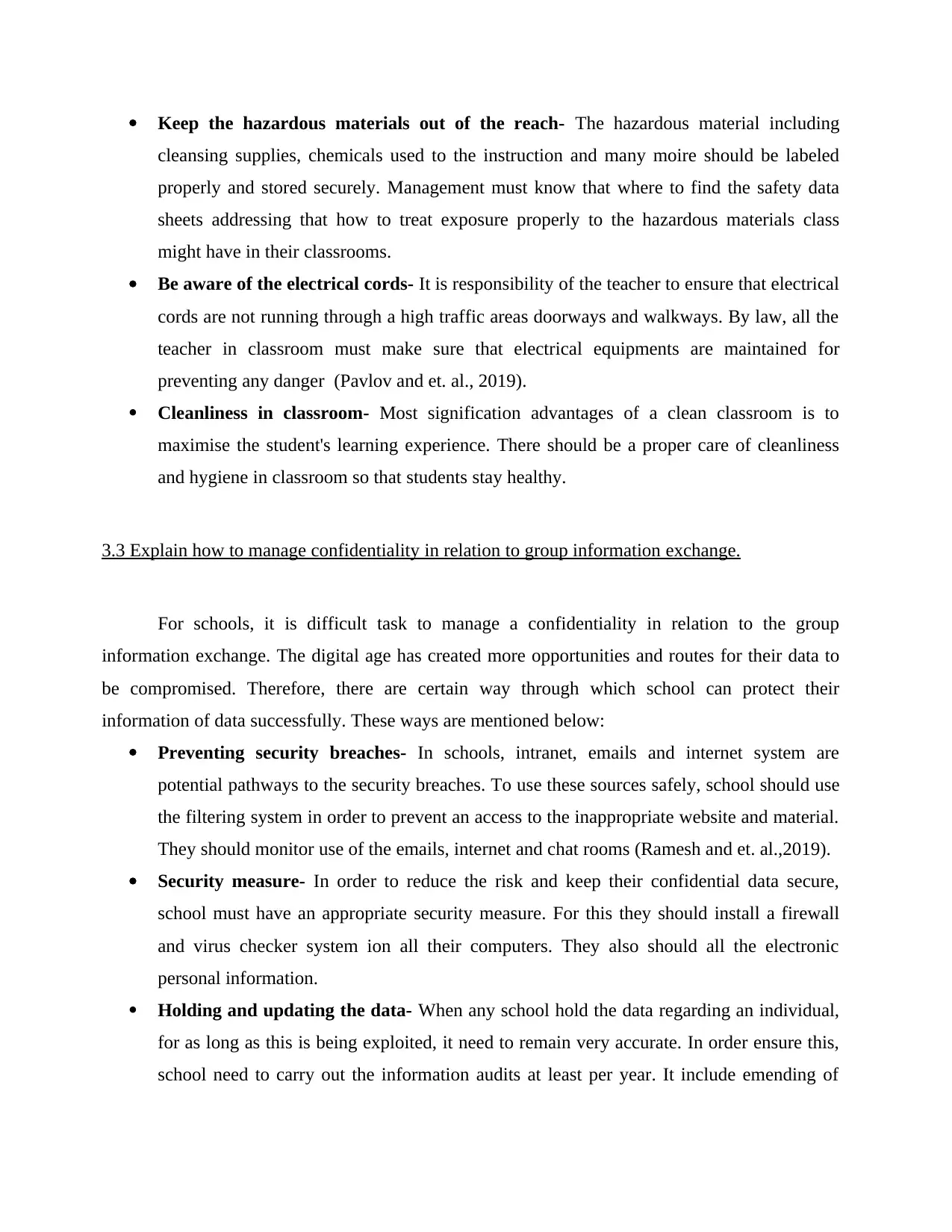
Keep the hazardous materials out of the reach- The hazardous material including
cleansing supplies, chemicals used to the instruction and many moire should be labeled
properly and stored securely. Management must know that where to find the safety data
sheets addressing that how to treat exposure properly to the hazardous materials class
might have in their classrooms.
Be aware of the electrical cords- It is responsibility of the teacher to ensure that electrical
cords are not running through a high traffic areas doorways and walkways. By law, all the
teacher in classroom must make sure that electrical equipments are maintained for
preventing any danger (Pavlov and et. al., 2019).
Cleanliness in classroom- Most signification advantages of a clean classroom is to
maximise the student's learning experience. There should be a proper care of cleanliness
and hygiene in classroom so that students stay healthy.
3.3 Explain how to manage confidentiality in relation to group information exchange.
For schools, it is difficult task to manage a confidentiality in relation to the group
information exchange. The digital age has created more opportunities and routes for their data to
be compromised. Therefore, there are certain way through which school can protect their
information of data successfully. These ways are mentioned below:
Preventing security breaches- In schools, intranet, emails and internet system are
potential pathways to the security breaches. To use these sources safely, school should use
the filtering system in order to prevent an access to the inappropriate website and material.
They should monitor use of the emails, internet and chat rooms (Ramesh and et. al.,2019).
Security measure- In order to reduce the risk and keep their confidential data secure,
school must have an appropriate security measure. For this they should install a firewall
and virus checker system ion all their computers. They also should all the electronic
personal information.
Holding and updating the data- When any school hold the data regarding an individual,
for as long as this is being exploited, it need to remain very accurate. In order ensure this,
school need to carry out the information audits at least per year. It include emending of
cleansing supplies, chemicals used to the instruction and many moire should be labeled
properly and stored securely. Management must know that where to find the safety data
sheets addressing that how to treat exposure properly to the hazardous materials class
might have in their classrooms.
Be aware of the electrical cords- It is responsibility of the teacher to ensure that electrical
cords are not running through a high traffic areas doorways and walkways. By law, all the
teacher in classroom must make sure that electrical equipments are maintained for
preventing any danger (Pavlov and et. al., 2019).
Cleanliness in classroom- Most signification advantages of a clean classroom is to
maximise the student's learning experience. There should be a proper care of cleanliness
and hygiene in classroom so that students stay healthy.
3.3 Explain how to manage confidentiality in relation to group information exchange.
For schools, it is difficult task to manage a confidentiality in relation to the group
information exchange. The digital age has created more opportunities and routes for their data to
be compromised. Therefore, there are certain way through which school can protect their
information of data successfully. These ways are mentioned below:
Preventing security breaches- In schools, intranet, emails and internet system are
potential pathways to the security breaches. To use these sources safely, school should use
the filtering system in order to prevent an access to the inappropriate website and material.
They should monitor use of the emails, internet and chat rooms (Ramesh and et. al.,2019).
Security measure- In order to reduce the risk and keep their confidential data secure,
school must have an appropriate security measure. For this they should install a firewall
and virus checker system ion all their computers. They also should all the electronic
personal information.
Holding and updating the data- When any school hold the data regarding an individual,
for as long as this is being exploited, it need to remain very accurate. In order ensure this,
school need to carry out the information audits at least per year. It include emending of
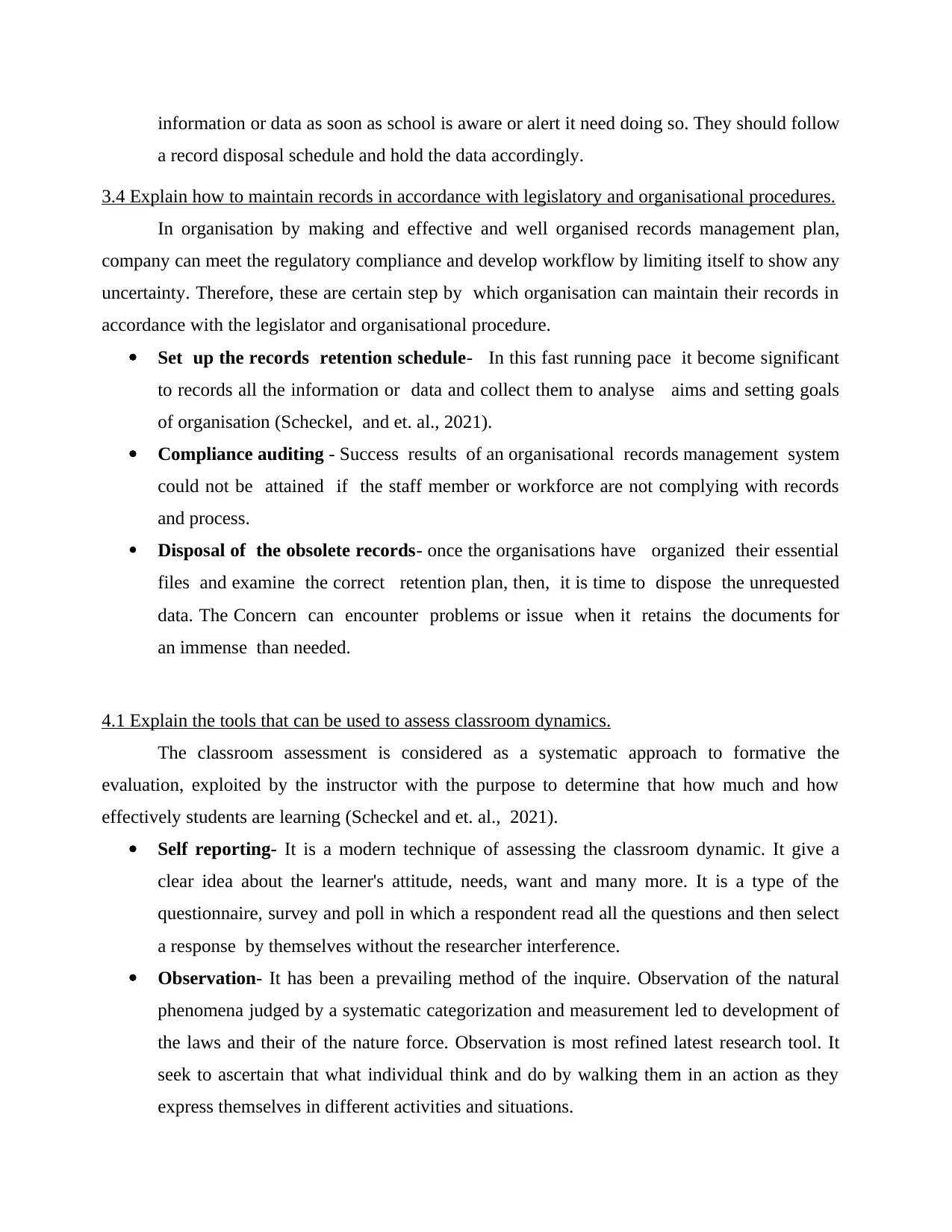
information or data as soon as school is aware or alert it need doing so. They should follow
a record disposal schedule and hold the data accordingly.
3.4 Explain how to maintain records in accordance with legislatory and organisational procedures.
In organisation by making and effective and well organised records management plan,
company can meet the regulatory compliance and develop workflow by limiting itself to show any
uncertainty. Therefore, these are certain step by which organisation can maintain their records in
accordance with the legislator and organisational procedure.
Set up the records retention schedule- In this fast running pace it become significant
to records all the information or data and collect them to analyse aims and setting goals
of organisation (Scheckel, and et. al., 2021).
Compliance auditing - Success results of an organisational records management system
could not be attained if the staff member or workforce are not complying with records
and process.
Disposal of the obsolete records- once the organisations have organized their essential
files and examine the correct retention plan, then, it is time to dispose the unrequested
data. The Concern can encounter problems or issue when it retains the documents for
an immense than needed.
4.1 Explain the tools that can be used to assess classroom dynamics.
The classroom assessment is considered as a systematic approach to formative the
evaluation, exploited by the instructor with the purpose to determine that how much and how
effectively students are learning (Scheckel and et. al., 2021).
Self reporting- It is a modern technique of assessing the classroom dynamic. It give a
clear idea about the learner's attitude, needs, want and many more. It is a type of the
questionnaire, survey and poll in which a respondent read all the questions and then select
a response by themselves without the researcher interference.
Observation- It has been a prevailing method of the inquire. Observation of the natural
phenomena judged by a systematic categorization and measurement led to development of
the laws and their of the nature force. Observation is most refined latest research tool. It
seek to ascertain that what individual think and do by walking them in an action as they
express themselves in different activities and situations.
a record disposal schedule and hold the data accordingly.
3.4 Explain how to maintain records in accordance with legislatory and organisational procedures.
In organisation by making and effective and well organised records management plan,
company can meet the regulatory compliance and develop workflow by limiting itself to show any
uncertainty. Therefore, these are certain step by which organisation can maintain their records in
accordance with the legislator and organisational procedure.
Set up the records retention schedule- In this fast running pace it become significant
to records all the information or data and collect them to analyse aims and setting goals
of organisation (Scheckel, and et. al., 2021).
Compliance auditing - Success results of an organisational records management system
could not be attained if the staff member or workforce are not complying with records
and process.
Disposal of the obsolete records- once the organisations have organized their essential
files and examine the correct retention plan, then, it is time to dispose the unrequested
data. The Concern can encounter problems or issue when it retains the documents for
an immense than needed.
4.1 Explain the tools that can be used to assess classroom dynamics.
The classroom assessment is considered as a systematic approach to formative the
evaluation, exploited by the instructor with the purpose to determine that how much and how
effectively students are learning (Scheckel and et. al., 2021).
Self reporting- It is a modern technique of assessing the classroom dynamic. It give a
clear idea about the learner's attitude, needs, want and many more. It is a type of the
questionnaire, survey and poll in which a respondent read all the questions and then select
a response by themselves without the researcher interference.
Observation- It has been a prevailing method of the inquire. Observation of the natural
phenomena judged by a systematic categorization and measurement led to development of
the laws and their of the nature force. Observation is most refined latest research tool. It
seek to ascertain that what individual think and do by walking them in an action as they
express themselves in different activities and situations.
⊘ This is a preview!⊘
Do you want full access?
Subscribe today to unlock all pages.

Trusted by 1+ million students worldwide
1 out of 17
Related Documents
Your All-in-One AI-Powered Toolkit for Academic Success.
+13062052269
info@desklib.com
Available 24*7 on WhatsApp / Email
![[object Object]](/_next/static/media/star-bottom.7253800d.svg)
Unlock your academic potential
Copyright © 2020–2025 A2Z Services. All Rights Reserved. Developed and managed by ZUCOL.
